Qualcomm Snapdragon 805 Performance Preview
by Anand Lal Shimpi on May 21, 2014 8:00 PM EST- Posted in
- Tablets
- Snapdragon
- Qualcomm
- Mobile
- SoCs
- Snapdragon 805
CPU Performance
As always we'll start out our performance investigation with a handful of CPU bound web browser based tests. In all cases we used Chrome on the MDP/T. Remember there's only an 8% increase in peak CPU frequency here, so I wouldn't expect a huge difference vs. Snapdragon 801.
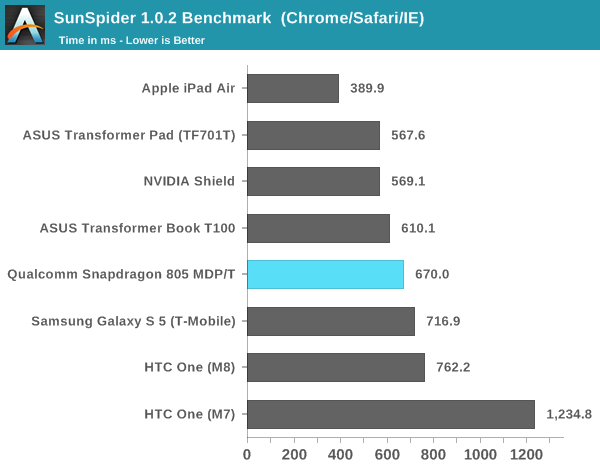
Here the MDP/T scales pretty well, showing a 6% improvement in performance over the Snapdragon 801 based Galaxy S 5. In the case of the GS5 we are looking at a 2.5GHz Snapdragon 801 implementation, so the improvement makes sense. Both the Cortex A15 (TF701T/Shield) and Apple's Cyclone (in the iPad Air) are higher performing designs here. Since there's no fundamental change to Krait's IPC, the only gains we see here are from the higher clock speed.
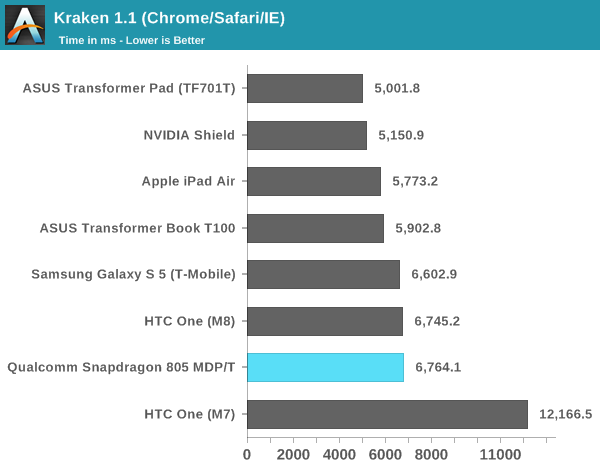
Kraken appears to be at its limit when it comes to Krait 400/450, there's effectively no additional frequency scaling beyond 2.3GHz. We're either running into an architectural limitation or limits of the software/browser combination itself.
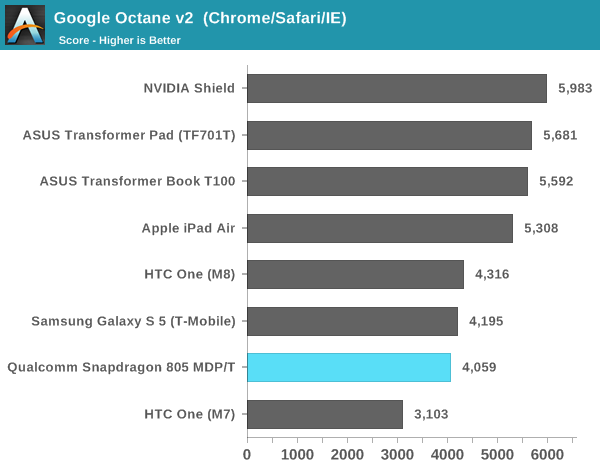
Similarly we don't see any real progress in the Google Octane test either. Snapdragon 805's CPU cores may run at a higher peak frequency but that's definitely not the story here.
Basemark OS II
Basemark OS II gives us a look at native application performance across a variety of metrics. There are tests that hit the CPU, GPU as well as storage subsystems here. The gains here are exclusively on the graphics side, which makes sense given what we've just seen. Snapdragon 805's biggest gains will be GPU facing.
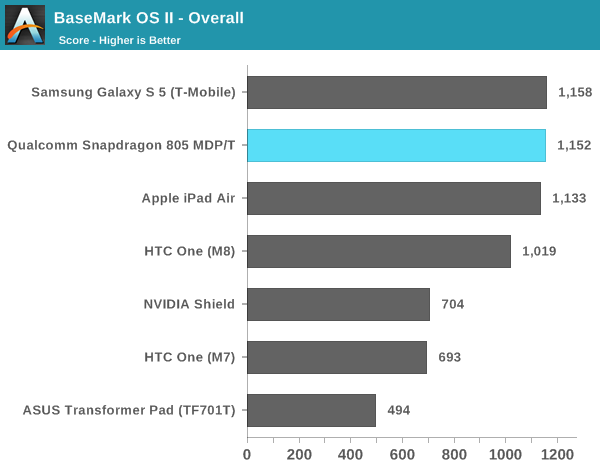
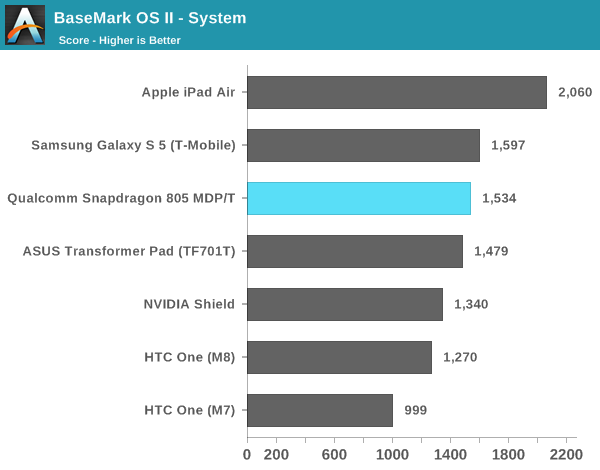


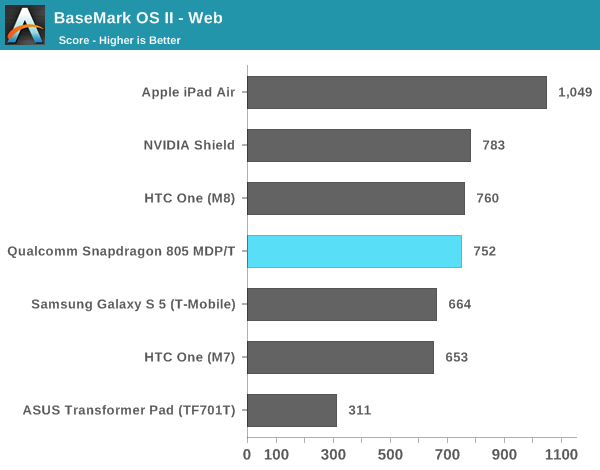
Geekbench 3.0
Although I don't typically use Geekbench, I wanted to include some numbers here to highlight that the increase in memory bandwidth for S805 over S801 doesn't really benefit the CPU cores:
| Geekbench 3.0 | |||||
| Snapdragon 801 2.3GHz (HTC M8) | Snapdragon 805 2.7GHz (MDP/T) | % Increase for S805 | |||
| Overall (Single thread) | 1001 | 1049 | 4.8% | ||
| Overall (Multi-threaded) | 2622 | 2878 | 9.7% | ||
| Integer (Single thread) | 956 | 996 | 4.2% | ||
| Integer (Multi-threaded) | 2999 | 3037 | 1.3% | ||
| FP (Single thread) | 843 | 925 | 9.7% | ||
| FP (Multi-threaded) | 2636 | 3155 | 19.7% | ||
| Memory (Single thread) | 1411 | 1406 | 0% | ||
| Memory (Multi-threaded) | 1841 | 1949 | 6% | ||
I wouldn't read too much into the multithreaded FP results, I suspect we're mostly seeing differences in thermal dissipation of the two test units. A closer look at the memory bandwidth numbers confirms that while the 805 has more memory bandwidth, most of it is reserved for GPU use:
| Geekbench 3.0 - Memory Bandwidth | |||||
| Snapdragon 801 2.3GHz (HTC M8) | Snapdragon 805 2.7GHz (MDP/T) | % Increase for S805 | |||
| Stream Copy (Single thread) | 7.89 GB/s | 8.04 GB/s | 1.9% | ||
| Stream Copy (Multi-threaded) | 9.53 GB/s | 10.1 GB/s | 5.9% | ||
| Stream Scale (Single thread) | 5.36 GB/s | 5.06 GB/s | - | ||
| Stream Scale (Multi-threaded) | 7.31 GB/s | 7.63 GB/s | 4.3% | ||
| Stream Add (Single thread) | 5.27 GB/s | 5.2 GB/s | - | ||
| Stream Add (Multi-threaded) | 6.84 GB/s | 7.51 GB/s | 9.8% | ||
| Stream Triad (Single thread) | 5.64 GB/s | 5.85 GB/s | 3.7% | ||
| Stream Triad (Multi-threaded) | 7.65 GB/s | 7.89 GB/s | 3.1% | ||










149 Comments
View All Comments
ArthurG - Thursday, May 22, 2014 - link
What do we care about clock speeds ? is it now a new metric of performance ? Is A7 running at only 1.3Ghz a slow SoC ? Architecture efficiency and final performance results are what we care about.What is important is that TK1 in MiPad destroys all other Android SoC by good margin (60fps T-rex vs 40 on S805) and with good power efficiency.
is it so difficult to admit it for nv haters ?
hahmed330 - Friday, May 23, 2014 - link
If I run my (nexus 7 2013) playing asphalt 8. My battery runs out in 2 hours only on 50% brightness.I can tell you Tegra K1+RAM on TK1 Jetson consumes 6980mW running full tilt at 950mhz for an actively cooled device. Now remember this is a non mobile device for developers.
ArthurG - Wednesday, May 21, 2014 - link
well your post shows big ignorance of the products.1/ Tegra 4 was on 28HPL process when S800/801/805 use 28HPM that provides nearly 30% better transistors. oranges vs apples and big advantage to QC
2/ T4 uses A15r1 that is not very well optimized for power efficiency. TK1 is now with A15r3 that provides better efficiency.
3/ Tegra K1 and S800/801/805 are made on the the same 28HPM process, so it's a fair comparison.
That means that T4 vs S800/S8001 was an easy win for QC due to many disadvantage over T4 design. But TK1 vs S80x shows completely different story with both using same node.
Finally, TK1 benchs are in the Xiaomi MiPad, a 7.9" tablet, no fan here, and it still smokes S805...
testbug00 - Thursday, May 22, 2014 - link
I will believe it when I See them... Also, the amazing "950Mhz" clockspeed of the K1? Guess where it is in the MiPad?In the 600Mhz range. NVidia has to downclock its parts to fit into tablets. Much less phones.
2. Process choice is a manufacturing choice. Nvidia could not get a HPM design? They suffered. Anyhow, Qualcomm will still probably smoke on pref/watt... which, once again, is what is really important in the phone and in most tablets.
3. Krait "450" cores are the same Krait cores from the 800 (a 2013 product) with more clockspeed. A15r3 is a 2014 product. I can throw meaningless garbage into "fair comparisons" also. You compare the SoC as a whole... K1 will end up faster than the 805. I am convinced of it. Will it matter? Not unless you are looking at putting a chip into a miniPC or a laptop... Or, perhaps a mobile-gamecontroller-with-a-screen. :)
Cannot wait for SHIELD 2.
kron123456789 - Thursday, May 22, 2014 - link
Read this:developer.download.nvidia.com/embedded/jetson/TK1/docs/Jetson_platform_brief_May2014.pdf
fivefeet8 - Thursday, May 22, 2014 - link
The MiPad can get the performance numbers they've shown with a GPU clocked at 600 mhz? And that's a bad thing?testbug00 - Thursday, May 22, 2014 - link
Depends on how/when Samsung, Qualcomm, Mediatek, Rockchip, etc. introduce their next generation chips and how fast they are.Apple's will likely beat this on GPU and CPU while using less power... Because, well, Apple has and continues to spend tons of money on optimization. The biggest part is die size... which is a huge advantage Apple has.
kron123456789 - Thursday, May 22, 2014 - link
Apple is using PowerVR GPU. And only GX6650 is comparable with Tegra K1(but it's have about 600-650MHz max frequency, and, because of that, less GFLOPS)testbug00 - Thursday, May 22, 2014 - link
and if the K1 cannot run at full clockspeed in phones/tablets due to setting reasonable clockspeeds or throttling?Or if PowerVR GPU adds more units, or raises Mhz (no reason to do these, as, raising power consumption (Without partial redesign) and these parts are typically "use X power, get as much speed as possible"
Or if Apple happens to license a GPU architecture from a company they are close with, say, PowerVR... ;)
ArthurG - Thursday, May 22, 2014 - link
apple faster ? proof ?All these SoC manufacturers rely on other companies tech to build their GPU. Unlike Nvidia, they can't come up with something new if their IP supplier doesn't have it. And for now, like it or not, no GPU available this year will be more powerful than mobile Kepler. Shallow it, you can't do anything against that.